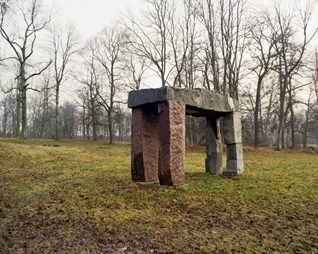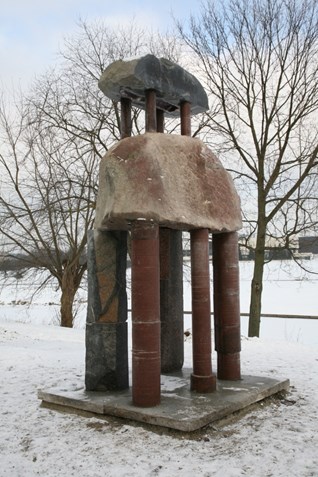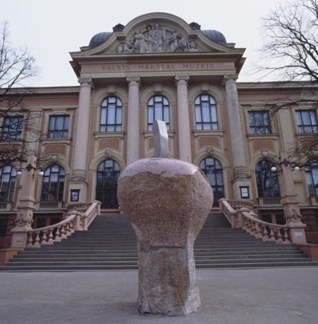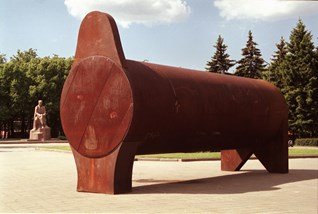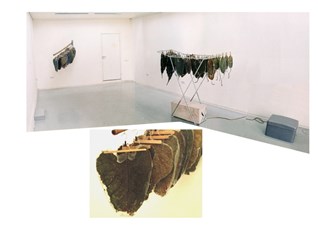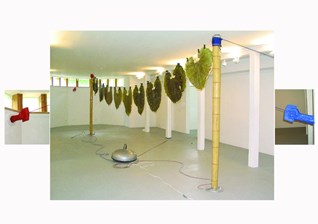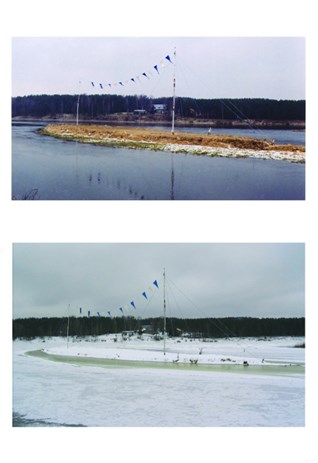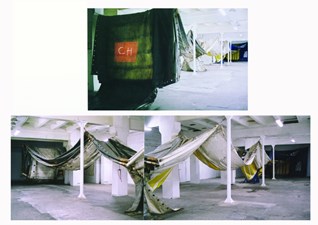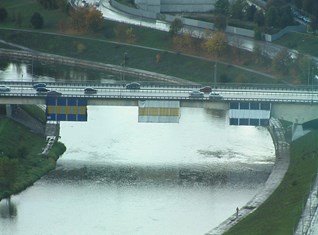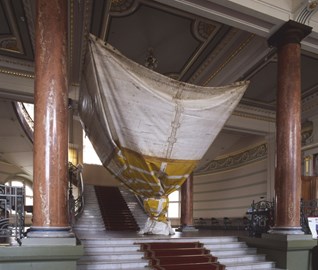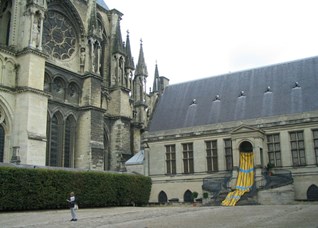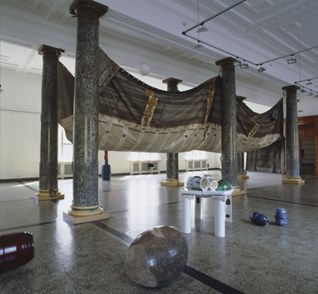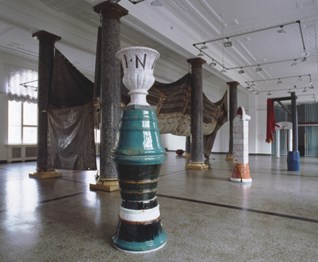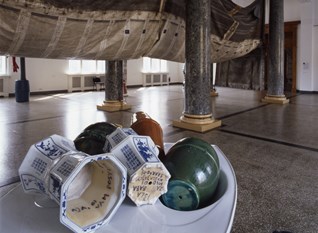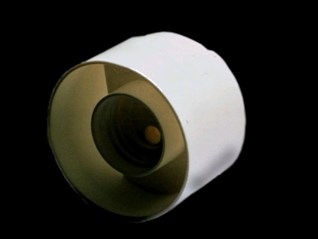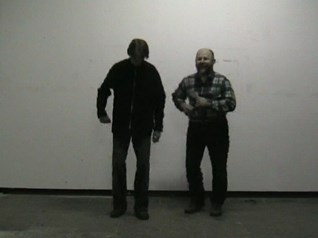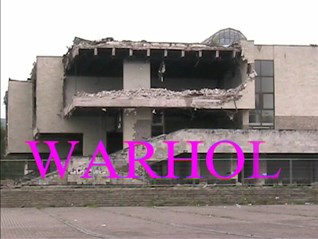The size of Navakas' works, the circumstances of their making, and their exposition, change with time, but what remains constant is [his] "elements of delicate thinking". Few people today remember thatShelter Dwas one of the six projects that received an award in the Vilnius Foundation Monument Competition in 1988. Citizens expressed their discontent with these projects devoted to Grand Duke Gediminas, the founder of the city ofVilnius, whose monument now stands in the centralsquareofVilnius.
His most recent work,Two-Storey, is a Baroque chapel (or dolmen) made into a neo-atrociously archaic construction surmounted with an amethyst geode. When you stand beneath it you can observe the history ofVilniusarchitecture unfold in front of your eyes. Once again, just like twenty years ago and theShelter D, it was received with a whiff of distrust, proving that citizens still lack nuance, culture, and wit.
The size of Navakas' works, the circumstances of their making, and their exposition, change with time, but what remains constant is [his] "elements of delicate thinking". Few people today remember thatShelter Dwas one of the six projects that received an award in the Vilnius Foundation Monument Competition in 1988. Citizens expressed their discontent with these projects devoted to Grand Duke Gediminas, the founder of the city ofVilnius, whose monument now stands in the centralsquareofVilnius.
His most recent work,Two-Storey, is a Baroque chapel (or dolmen) made into a neo-atrociously archaic construction surmounted with an amethyst geode. When you stand beneath it you can observe the history ofVilniusarchitecture unfold in front of your eyes. Once again, just like twenty years ago and theShelter D, it was received with a whiff of distrust, proving that citizens still lack nuance, culture, and wit.
The size of Navakas' works, the circumstances of their making, and their exposition, change with time, but what remains constant is [his] "elements of delicate thinking". Few people today remember thatShelter Dwas one of the six projects that received an award in the Vilnius Foundation Monument Competition in 1988. Citizens expressed their discontent with these projects devoted to Grand Duke Gediminas, the founder of the city ofVilnius, whose monument now stands in the centralsquareofVilnius.
His most recent work,Two-Storey, is a Baroque chapel (or dolmen) made into a neo-atrociously archaic construction surmounted with an amethyst geode. When you stand beneath it you can observe the history ofVilniusarchitecture unfold in front of your eyes. Once again, just like twenty years ago and theShelter D, it was received with a whiff of distrust, proving that citizens still lack nuance, culture, and wit.
Since 1990, Mindaugas Navakas has been making sculptures from steel, and taking exhibition objects of sculpture from their pedestals to hang them on walls and exhibits them loosely within exhibition space. In 1994, the artist co-operated withMeno Lygaand theJutempusgallery to use the façade of the previous Railway Workers' Culture House to installKablys(The Hook), which became an iconic sign of change reproduced in international publications discussing changes in East andCentral Europe.
Three Great Dependents,created around the same time, offers an interactive dialogue with their surroundings. The segments were designed to allow for variation in their composition, and are displayed by leaning them against façades of different buildings, joining them by two or three and exposing them to urban natural space, each time creating new scenarios. Starting in 2000, the author has taken an interest in transforming large capacity tanks, waste containers, and construction beams into sculptures. At the moment, the works are on public display in the yard of a former collective farm in Savičiūnai, where a colony of artists work in the now privatised premises. The tanks, intended for diesel fuel and liquid nitrogen fertilizers (ammonia and hydrogen) were sold to Mindaugas Navakas by the administrators of a nearby collective farm following their bankruptcy.
Mindaugas Navakas uses recyclable materials and malleable in his work. Silicone first found a place in his practice as means to construct transparent objects, and later to stiffen and reinforce material in order to preservefragile objects.
In 2003-2004, Navakas showcased objects made from recycled household items, a soundtrack made by the author "trapped" in a handmade speaker, and an existentialist herbarium (a collection of giant silicon impregnated burdock leaves). The installations can be interpreted in many ways, balancing between organic discomfort and surrealistic elegance. (See Andriuškevičius A. Esu skulptūros istorija (I am the History of Sculpture), in:Šiaurės Atėnai, 2003 04 19)
Mindaugas Navakas uses recyclable materials and malleable in his work. Silicone first found a place in his practice as means to construct transparent objects, and later to stiffen and reinforce material in order to preservefragile objects.
In 2003-2004, Navakas showcased objects made from recycled household items, a soundtrack made by the author "trapped" in a handmade speaker, and an existentialist herbarium (a collection of giant silicon impregnated burdock leaves). The installations can be interpreted in many ways, balancing between organic discomfort and surrealistic elegance. (See Andriuškevičius A. Esu skulptūros istorija (I am the History of Sculpture), in:Šiaurės Atėnai, 2003 04 19)
A one-year long project took place on an island at the junction of the Nemunas and Merkys rivers. The project was based on the idea of transforming the island into a ship. This "ship" was left over the winter to be destroyed by an ice-drift. The project focused our attention on the artist's vital and contextual relation to nature. The project marked Navakas' first use of polyvinyl acetate/polyester fabric, used as canopies on long-wheel base freight trucks.
(See Sluckaitė-Jurašienė, A.M. Vėliavos Nemune ("Flags on the Nemunas"), in:Kultūros barai, 2006, Nr. 1, p.27-31)
The installations created using old freight canopies are proof of Navakas' consistent enthusiasm for making new connections between a readymade and a site. The artist appreciates the material for its size, flexibility and strength, while in the sculptural process it also raised the universal questions of transit, migration and safety.
The installations created using old freight canopies are proof of Navakas' consistent enthusiasm for making new connections between a readymade and a site. The artist appreciates the material for its size, flexibility and strength, while in the sculptural process it also raised the universal questions of transit, migration and safety.
The installations created using old freight canopies are proof of Navakas' consistent enthusiasm for making new connections between a readymade and a site. The artist appreciates the material for its size, flexibility and strength, while in the sculptural process it also raised the universal questions of transit, migration and safety.
The installations created using old freight canopies are proof of Navakas' consistent enthusiasm for making new connections between a readymade and a site. The artist appreciates the material for its size, flexibility and strength, while in the sculptural process it also raised the universal questions of transit, migration and safety.
In his contemplation of the Lithuanian cult of consumerism, Mindaugas Navakas creates remakes from faience and plastic materials. "These are not exactly ready-made objects and here, the choice is not more important than their transformation. While everyone is fighting the virus of consumerism, Navakas buys cheap china vases stacks them, then ties them with fireproof wire, glazes them and anneals them. He turns standard goods into odd and non-functional ones and builds still-lives with things that look like columns. Or he constructs lofty porticos and columns with vases with Russian swear-words written on them in Latin letters."
(See Kreivytė L. Quo vadis? Mindaugo Navako "Girlianda" arba Viešumos "išdūrimas", (Quo vadis?Garlandby Mindaugas Navakas or Making Tricks with Publicity), in:7 meno dienos, 2005 02 11)
In his contemplation of the Lithuanian cult of consumerism, Mindaugas Navakas creates remakes from faience and plastic materials. "These are not exactly ready-made objects and here, the choice is not more important than their transformation. While everyone is fighting the virus of consumerism, Navakas buys cheap china vases stacks them, then ties them with fireproof wire, glazes them and anneals them. He turns standard goods into odd and non-functional ones and builds still-lives with things that look like columns. Or he constructs lofty porticos and columns with vases with Russian swear-words written on them in Latin letters."
(See Kreivytė L. Quo vadis? Mindaugo Navako "Girlianda" arba Viešumos "išdūrimas", (Quo vadis?Garlandby Mindaugas Navakas or Making Tricks with Publicity), in:7 meno dienos, 2005 02 11)
In his contemplation of the Lithuanian cult of consumerism, Mindaugas Navakas creates remakes from faience and plastic materials. "These are not exactly ready-made objects and here, the choice is not more important than their transformation. While everyone is fighting the virus of consumerism, Navakas buys cheap china vases stacks them, then ties them with fireproof wire, glazes them and anneals them. He turns standard goods into odd and non-functional ones and builds still-lives with things that look like columns. Or he constructs lofty porticos and columns with vases with Russian swear-words written on them in Latin letters."
(See Kreivytė L. Quo vadis? Mindaugo Navako "Girlianda" arba Viešumos "išdūrimas", (Quo vadis?Garlandby Mindaugas Navakas or Making Tricks with Publicity), in:7 meno dienos, 2005 02 11)
Whilst creating set designs for operasPeer Gynt(1997) andBear(1999) the sculptor discovered slide projection technology. Later, he also discovered video. In his first video artworkLitter and Lids, the fragmented objects are sculpturally documented using principles of still photography, and are also similar to the image assemblage principles applied in slide projections.
In his video workTen Years After, Navakas turns performer and, together with the painter Jonas Gasiūnas, performs a monotonous one-step dance in front of the camera for half an hour. The static camera records their rhythmically repetitive movements. At the end, the viewer learns from the vignette that the work is dedicated to the tenth anniversary of the creative cooperation between the two artists, developed without belonging to any professional artists' association (in1993, inprotest against the unwillingness of the Lithuania's Artists Association to transform, the two artists left the organization).
In his videoNac.Gal., the artist turns the camera on modernity (in architecture) and tests its limits in the local context.



